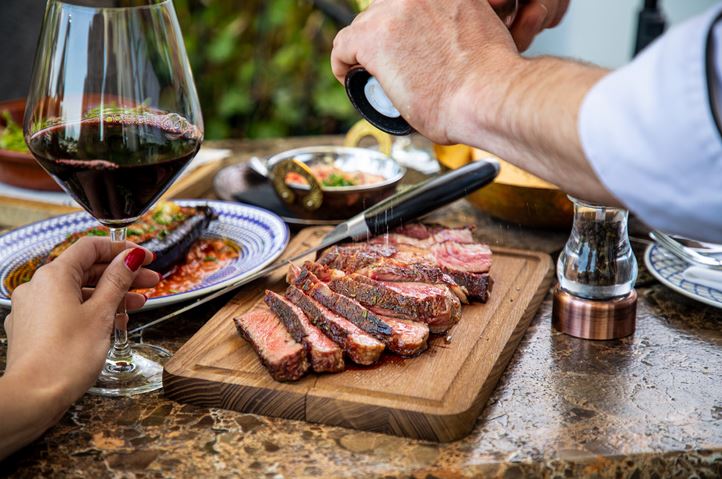Before we start talking about tenderizing meat, did you know that meat consists of muscle tissue held together through collagen, a protein thread? The long muscle fibres in meat need to be cut and loosened up to transform into gelatin in order for the flesh to be tenderized. This pliable gelatin penetrates the flesh and adds hydration, making the steak tender and luscious.
Tenderizing is beneficial for harder cuts of steaks with a bit of fibrous tissue because it helps break the strands in the steak, which in turn makes the meat simpler to prepare, slice, and consume. The meat can be made extra tender through a procedure known as tenderizing, which involves tearing down the soft tissue in the flesh. Hammering, simmering, and slow cooking are just a few of the many methods that may be used to tenderize meat.
Knowing how to tenderize steak is essential for anyone who loves to cook. It will allow you to provide protein-rich dishes without breaking the bank. Overall, there are seven different ways that you can do to tenderize a steak, and we provided all the necessary information below.
1. Pounding
Meat mallets help to relax and tenderize meats. Before cooking, pound meats with plastic wrap and greaseproof paper. You may use a saucepan, pot, or rolling pin instead of a meat mallet when you don’t have one. Meat mallets must have flat and spiked sides. The prickly points cut fibres and muscle to cook meat quickly. The spiky spikes cause deep gouges in the meat, which simulate small cubes, hence tiny, thin slices of beef (usually a top circle or sirloin) are occasionally labelled as cubed meat. Compressing the meat with a mallet lets it avoid overcooking. Pounding is best for thinner, juicy meat.
2. Salting
Salting steak nearly an hour before it is cooked brings out the best flavour in almost all meat cuts, but notably in the more chewy slices. Salt, in addition to imparting flavour to the meat, has a role in the protein breakdown, which in turn makes the steak softer. First, generously salt the cuts for at least one hour before beginning the cooking process, and then continue with the procedure as directed. During the moment that the griddle is heating up in this preparation for Seasoned Salt, a spiced sodium combination is allowed ample opportunity to permeate New York slices.
3. Velveting
The Chinese technique known as “velveting” involves simmering the meats in a mixture made from cornstarch before cooking them. Starch, oyster sauce, and tahini, along with other flavourings such as rice wine and oyster sauce, are the standard ingredients in the cornstarch combination. The sliced brisket steak has been velveted to make them more tender before being stir-fried. Velveting your steak not only makes it more tender but also forms a covering that aids in colouring and makes it easier for the gravy to stick to the meat.
4. Marinating
To assist in the breaking of tough connective tissues and muscles, you can make a marinade using acidic ingredients like lime juice, buttermilk, dairy, beer, wine, or soda. These ingredients can also be used individually. Just add any of these acidic compounds to a solution, and then use it on hard, thin pieces of meat like skirt steak, top sirloin, tri-tip rib eye, and flank steak. The acidity portion of a marinade might be different depending on the dish, and also the meat cut used. The use of
orange juice is essential to any recipe.
5. Scoring
Cutting tiny slices into the surface of the meat is what is meant by “scoring.” Since chopping the flesh severs the lengthy fibres, which make it difficult to digest, this is an effective method for tenderizing harder cuts of meat, such as flank, which can be difficult to chomp down.
6. Application of Enzyme
Enzymes found in particular fruits, such as kiwis, plantains, pineapples, and Asian peaches, are capable of effectively easing the chewiness of tough cuts of meat. Simply incorporate additional fruit into your preparation at a ratio of one to two teaspoons of fruits per quart of marinade, then ensure that the meat does not marinate for longer than 12 hours. Similar to the case with other kinds of marinades, that approach is most successful with more delicate pieces of meat, including hangers or short cuts.
7. Slow Cooking
The connective tissue inside the steak is subdivided, and collagen is released during the reduced cooking time, which results in beef that is tender and easily shreddable. Examples of methods that involve slow cooking are braised meats, barbecuing, and sous vide. Both braising and grilling are excellent cooking methods for tougher kinds of meat including beef, bottom rounds, and chop.

